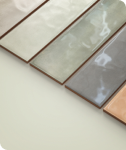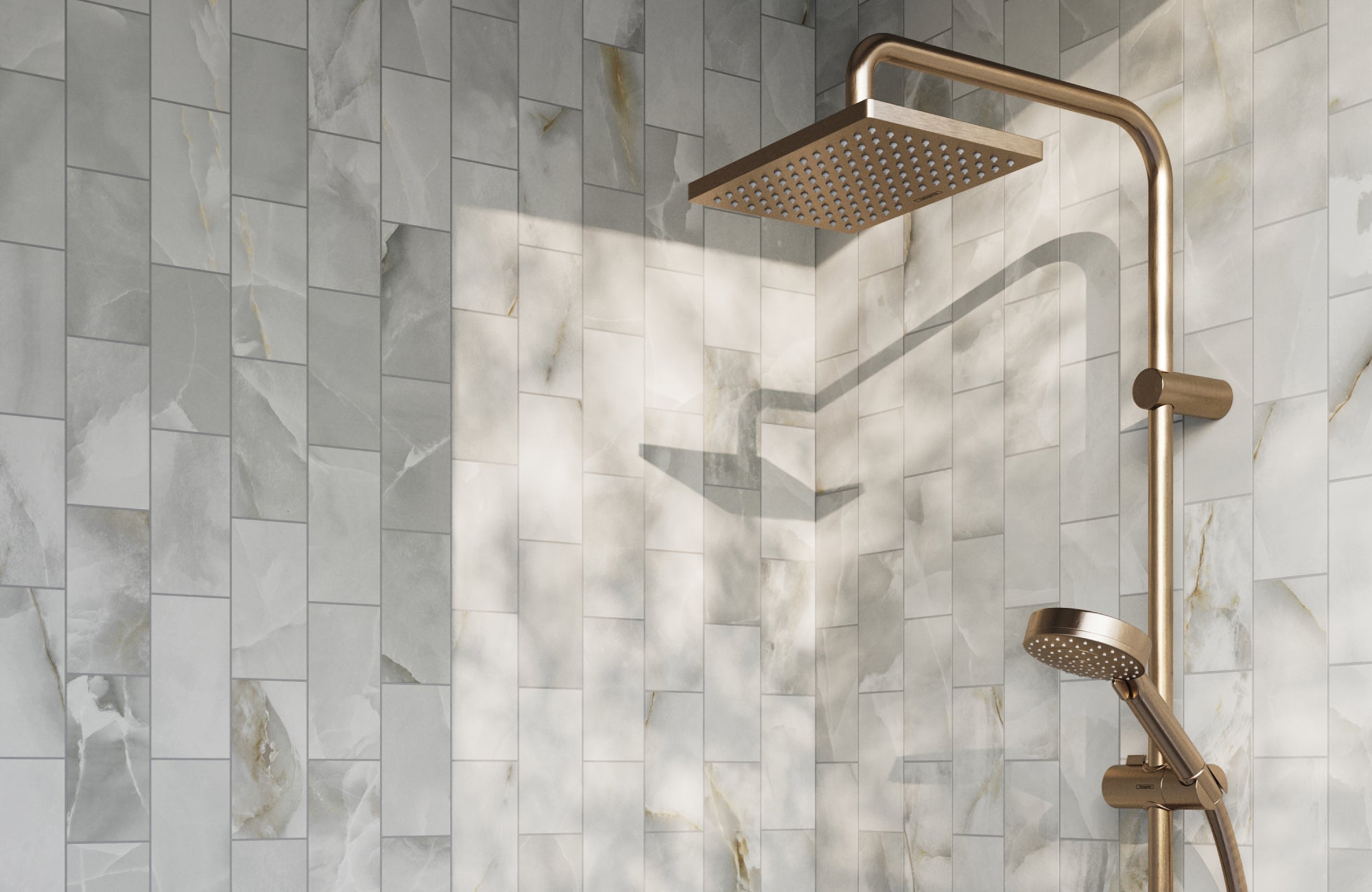For generations, subway tile has graced the walls of numerous spaces, carrying with it a timeless appeal. Originally sized at a classic 3” x 6”, today’s versions have evolved, boasting new trends in materials, sizes, proportions, and textures. But why do we call it "subway tile"?
Is the name derived from its elongated shape, reminiscent of a subway car? Or is it considered a "sub" for traditional square tiles? In truth, the name’s origin is far simpler…

Overview and History
Subway tile was specifically designed for the subway tunnels of New York City. The city’s inaugural subway system was launched in 1904, conceived by designers George C. Heins and Christopher Grant LaFarge. They envisioned subway stations that were as aesthetic as they were functional, especially vital as underground transit was a novel concept for many at the time. Vaulted ceilings, skylights, and intricate tile mosaics adorned the first ticketing stations.
Subway tiles quickly became integral to the subway system's success, lining station walls and routes. Their bright, white ceramic surfaces were not just aesthetically pleasing but practical; their reflective nature maximized the sparse light in underground passages.
Moreover, the ease of maintaining these glossy white tiles made them a hit among Victorian city dwellers, who prized cleanliness and hygiene. This led to the tiles' proliferation in other hygiene-critical areas like kitchens, hospitals, food shops, and residential bathrooms, reaching peak popularity in the 1920s and '30s. Although available in various colors, white remains a favorite.
Modern Styles, Classic Appeal
Today, subway tile is enjoying a revival, driven partly by nostalgia for traditional design aesthetics like farmhouse, rustic, and cottage themes. These tiles fit seamlessly into classic backsplash designs, enhancing even retro and industrial decors with options ranging from neutral beige to classic white.
Another draw is the vast array of subway tiles now available. Modern variations include tiles in any imaginable color, crafted not only from traditional ceramics but also from materials like porcelain, glass, and natural stone. Some subway tiles might feature artisan glazes, crackled finishes, and unique beveled edges that introduce character and depth, as offered by Edward Martin. A standout example is our Natasha 2x6 Glossy Porcelain Tile in Oat, as shown in the photo above, which combines a warm neutral tone with a sleek glossy finish—ideal for creating a soft, refined look in both modern and transitional interiors. To truly appreciate the quality and variety of our offerings, consider exploring our free samples.
Size and proportion are also no longer limitations; the term "subway tile" now applies to any rectangular tile approximately twice as long as it is high, from tiny pieces to larger blocks and strips.
What remains consistent with the original design, however, are the simple lines, ease of maintenance, and versatility. We can use them for accent walls, backsplash designs, or to cover entire rooms, echoing the original subway designers' blend of beauty and practicality in modern homes.
Creative Ways to Use Subway Tile
Subway tile’s versatility extends far beyond backsplashes. Here are a few creative ways to incorporate it throughout your home.
In the Kitchen
The kitchen is the most popular space for subway tile, often used as a backsplash. Its smooth, glazed surface makes it easy to wipe down, while the tile’s clean lines and timeless appeal enhance nearly any style—be it traditional, farmhouse, or contemporary. For example, our Aniston 3x12 Polished Porcelain Tile in Calacatta Quarzite from Edward Martin offers a sophisticated marble look with subtle veining and a polished finish, bringing a luxurious touch to backsplashes or even custom range hoods. Subway tile can also be used on kitchen walls, island fronts, or to create a cohesive, high-end look throughout the space.
In the Bathroom
In bathrooms, subway tile shines on shower walls, tub surrounds, and as wainscoting. Its moisture resistance and clean appearance make it ideal for wet spaces. While traditional white remains a favorite for a spa-like aesthetic, incorporating colored or textured tiles can lend a more personalized, modern feel. For instance, Edward Martin’s Graham 3x6 Glossy Ceramic Tile in Clay, as seen above, adds warmth and subtle sophistication, making it a stylish alternative that still maintains the timeless appeal of classic subway tile.
Beyond Kitchens and Baths
Subway tile isn’t just limited to kitchens and bathrooms. It’s perfect for laundry rooms, mudrooms, and entryways where easy-to-clean surfaces are essential. For example, our Maisie 2.5x16 Glossy Ceramic Tile in Canvas brings a soft, refined tone and an elongated shape that’s ideal for creating stylish, functional surfaces in these busy areas. Subway tile also works beautifully around fireplaces or as an accent wall in hallways or living rooms, providing subtle pattern and texture while maintaining a clean and polished look.
Reinventing a Classic for Every Space
With its origins in early 20th-century public transportation, subway tile has grown into a beloved staple of home design. Its evolution in materials, finishes, and formats has only expanded its versatility, making it a perfect fit for nearly every space in the modern home. From kitchens to fireplaces, matte to glossy, minimalist to detailed—subway tile continues to balance form and function with timeless appeal.
Curious how subway tile would look in your home? Curious how subway tiles would look in your space? Try our cutting-edge augmented reality (AR) tool to visualize the impact these subway tiles could make in your home, tailored to your unique style and layout.
Frequently Asked Questions
Got more questions about subway tiles? Whether you're considering them for your next project or just curious about their versatility and care, our FAQ section covers the essentials.
1. Can subway tiles be used in outdoor spaces?
Yes, subway tile can be used outdoors, provided it's rated for exterior use. Ensure the tile is frost-resistant and non-porous to withstand various weather conditions.
2. Are subway tiles difficult to install?
Subway tiles are relatively easy to install, making them a popular choice for DIY projects. However, for the best results, especially to ensure even spacing and alignment, it’s advisable to use the right tools and techniques. We recommend consulting a professional installer to guarantee a flawless finish, particularly for more complex layouts or larger areas.
3. How do you clean subway tiles?
Cleaning subway tiles, particularly those crafted from ceramic or porcelain, is straightforward. Regular wiping with a mild soap and water solution is sufficient for daily maintenance.
4. What grout color should I use with subway tiles?
The choice of grout color can significantly affect the appearance of your subway tile installation. For a classic look, white grout pairs well with white tiles. For a more pronounced, graphic effect, contrasting grout colors, like black or gray, can be used.
5. Do subway tiles go out of style?
Subway tiles have been in use for over a century and continue to be a staple in both traditional and modern designs due to their versatility and timeless appeal. While trends may shift, subway tiles remain a popular choice for their classic look and adaptability.










